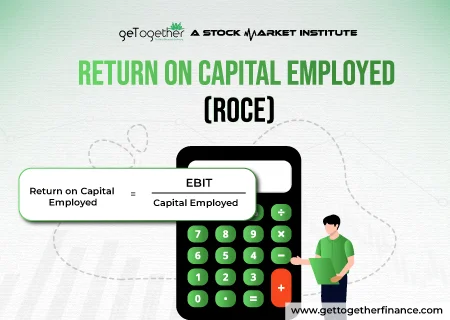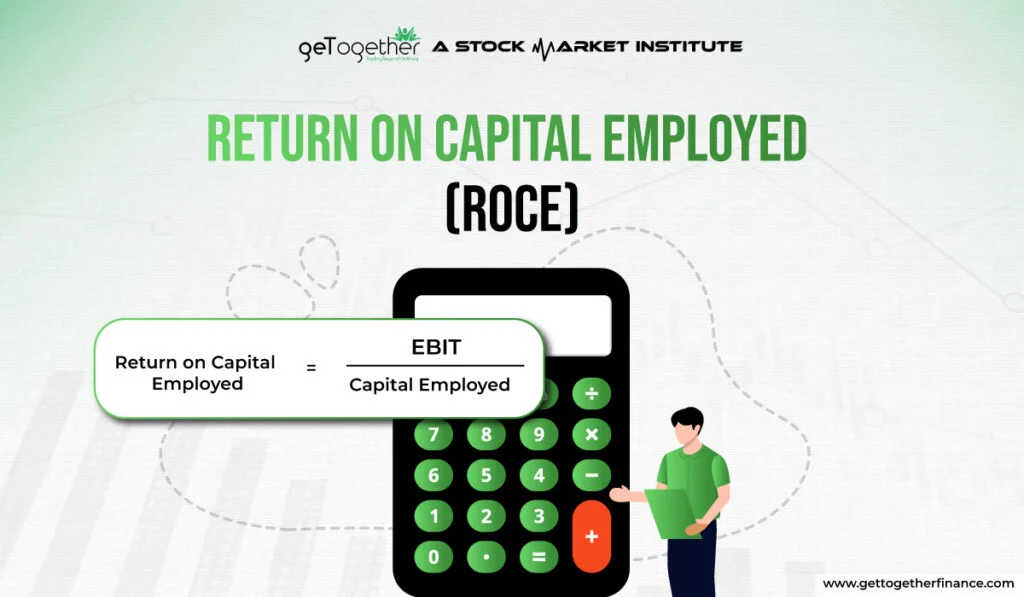Return on Capital Employed (ROCE)
- May 28, 2024
- 990 Views
- by Manaswi Agarwal


Return on Capital Employed or ROCE is a profitability ratio that determines the ability of a company to generate profits. It analyzes how the company uses its capital to generate maximum returns. Investors use ROCE as a part of progress analysis to contemplate and make a decision to invest in a company or not. The ratio serves as an efficient management tool to assess the performance of businesses by considering the profits generated over extended periods.
Table of Contents
ToggleWhat is Return on Capital Employed?
Return on Capital Employed is used by investors to assess the financial position of the company by analyzing its profitability and capital efficiency. ROCE is a financial ratio that helps investors to analyze how the company generates profits to guide financial managers, stakeholders, and investors to make effective decisions regarding investments.
How to calculate ROCE?

ROCE is calculated by dividing the earnings before interests and taxes with the capital employed. To calculate ROCE, the formula is: EBIT/ Capital Employed
Return on Capital Employed formula
Return on Capital Employed = EBIT/ Capital Employed
EBIT: EBIT belongs to Earnings before Interest and Tax and EBIT represents the operating income of a company and helps to analyze company’s operations that exclude interest and taxes. EBIT is calculated by subtracting the revenue from the cost of goods sold and operating expenditures.
Capital Employed: Capital Employed is the difference between total assets and current liabilities. It indicates the total invested amount by an investor which is obtained by deducting current obligations from total assets, yielding shareholders equity plus long term loans.
Also Read: Balance Sheet
What is the importance of ROCE?

Investors should track ROCE to measure the overall performance of a company through profitability and capital efficiency. It is an important tool to assess and compare the performances of various companies and allow proceeding with better investment strategies and resource allocation. ROCE provides a long term perspective of a company’s profitability and efficiency. ROCE is essential for companies in many ways:
Assess company’s profitability
ROCE assists investors to evaluate a company’s profitability to analyze its efficiency to use the capital in business operations. An investor considers ROCE as an essential statistic to make investment choices based on the company’s efficiency to generate profits.
Helps in comparison of companies
ROCE identifies the efficiency of companies to generate earnings from their capital. The investors can compare different companies based on their earnings to identify potential profitable investment opportunities.
Financial Health Indicator
It is important for investors to analyze ROCE as a consistent growth in ROCE represents a company’s strong financial health of the company with a robust business model. A constant increase in ROCE recommends that the company is able to sustain its profits over a period of time.
Cost of Capital Assessment
ROCE is compared to the total company’s cost of capital and if it is greater than the cost of capital then it is indicated that the company is able to generate value for its shareholders. If the ROCE is lower than the cost of capital then the company might be destroying its value.
Limitations of ROCE

It is not easy to directly compare the companies of different sectors based on ROCE. ROCE does not consider some important elements of financial performances that include growth, margin, creation of cash flow, and return on equity. Also, ROCE is more prone towards manipulation through financial indicators and accounting techniques. Investors cannot completely rely on ROCE to assess a company’s financial position as it has a limited viewpoint and might not adequately evaluate a company’s current situation and future prospects. Using ROCE has several limitations apart from the benefits that it gives.
Ignores Cost of Capital
The calculation of returns on capital employed does not consider the cost of capital. Ignoring cost of profitability does not reveal actual profitability of the business. A company which has high ROCE with a high cost of capital might not generate enough earnings to cover the cost of capital.
Doesn’t count non-operating income
While calculating ROCE, operating profit is considered which doesn’t include income like interest and tax expenses. It does not provide complete information about the profitability of the company. If non operating income consists of a significant portion of a company’s total income then the actual profitability revealed would not be true enough.
Asset Valuation Variability
Asset revaluations or write offs can impact the value of capital employed. The accounting decisions taken might significantly impact the return on capital employed that can distort the true operational performance of the company.
Influence of capital structure
Return on Capital Employed does not differentiate between the companies that have different capital structures. A company which has high debt can show similar ROCE as the company with low debt levels.
Short – Term Focus
One of the limitations is that companies might focus on short term returns rather than long term growth. Short term gains are preferred by companies where they let go of the long term gains.
Cut it Short
Return on Capital Employed is a financial ratio with the help of which investors can assess the financial position of a company to make their investment decisions. It is an effective method to calculate a company’s profitability while analyzing the basics and fundamentals. Conversely, the demand and supply theory of GTF is based on technical analysis which has proven its efficiency over a period of time.
FAQs
Q1. What is Return on Capital Employed?
Return on capital employed is a financial ratio which is helpful to measure the company’s profitability and its capital efficiency.
Q2. How is ROCE calculated?
ROCE is calculated by dividing the earnings before interest and taxes by the amount of capital employed. It can also be determined by dividing profits before interest and taxes by the difference of total assets and current liabilities.
Q3. Why is ROCE important?
ROCE is important to identify the profitability and capital efficiency of the company which helps the investors to decide if they should invest or not in that particular company.
Q4. What is a good ROCE ratio?
It has been identified that higher the ROCE ratio, the better it is for the investors. Usually ROCE of 20% depicts a good financial position of the company; however, the ratio differs for various industries.
Q5. What is the capital employed?
Capital employed is gained when current liabilities are deducted from the total assets. Capital employed represents the amount of investment.



 Instagram
Instagram
